Interrupted Fort
Asiago

The construction of Fort Interrotto began in the second half of the 19th century and was completed in 1887. The structure is made entirely of stone and brick and was conceived as a defensive barracks to house the ‘Bassano’ Alpine Battalion. During World War I, the building was used as a fortress, with the task of constituting a barrage in the upper Val d’Assa in the event of an Austrian advance, assisted by the Tagliata Val d’Assa and the batteries of Monte Rasta below. In May 1916 it was directly involved in the events of the war and occupied by the Austro-Hungarian army during the advance towards Asiago. It was then adapted and reused as an observatory on the Plateau and in this circumstance was equipped with several beacons and small-calibre cannons.
The history of this fort continued after the end of the war when it was used by the Italian Army as a target during exercises, which took place for decades on the Asiago Plateau until the second half of the last century. Since 2005, it has undergone recovery and static consolidation on the initiative of the municipality of Asiago, becoming part of the ‘Ecomuseum of the Great War of the Vicenza Pre-Alps’.
The site is freely accessible.
In the case of snow, the road is closed and the site cannot be reached by car.
For information and guided tour bookings:
Plateau Guides Tel. 340 7347864 e-mail: info@guidealtopiano.com
Asiago Guide Tel. 346 2379118
e-mail: info@asiagoguide.com cell.
Tourist Information Desk
Tel. 0424 462221
e-mail info@asiago.to
How to get there
The fort is located above the village of Camporovere. By car, it can be reached from Asiago by following State Road 349, which leads to Trento. At the height of the village of Camporovere, turn into Via Monte Interrotto, climbing first to Monte Rasta (where the asphalt road ends) and then, with a series of wide hairpin bends, arriving directly at the summit of Monte Interrotto. On foot, following the path that climbs from Contrade Lamara and Buscar to the north of Asiago.
In the case of snow, the road is closed and the site cannot be reached by car.
how to reach us